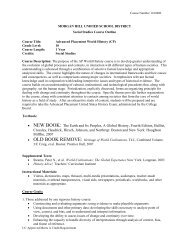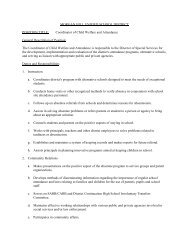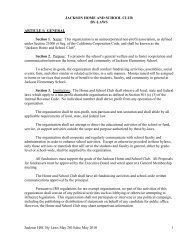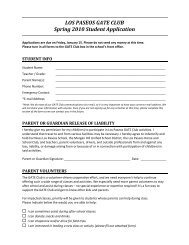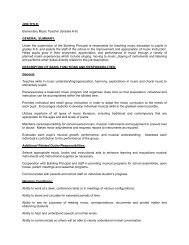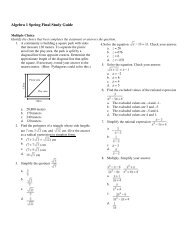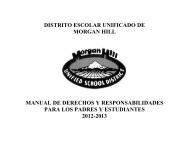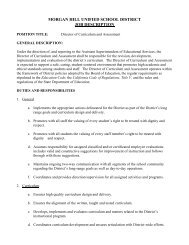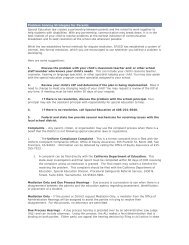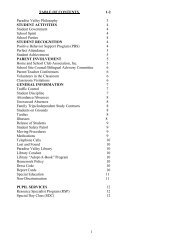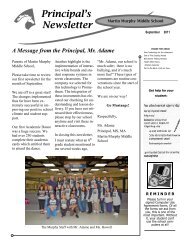8th Grade US History
8th Grade US History
8th Grade US History
Create successful ePaper yourself
Turn your PDF publications into a flip-book with our unique Google optimized e-Paper software.
Course OutlineCourse Title: U.S. <strong>History</strong>Course Length: 1 year<strong>Grade</strong>s: 8Course DescriptionStudents in grade eight study the ideas, issues and events from the framing of the Constitution up toWorld War I, with an emphasis on America’s role in the war. U.S. <strong>History</strong> 8 may be taught in anintegrated core class with language arts.TextsAmerican Journey, Building a Nation by Glencoe, 2000Instructional Materials:• Videos, dictionaries, thesauri, multi-media presentations, audiotapes, teacher-madematerials, overhead transparencies, visual aids, newspapers, periodicals, workbooks, andother materials as appropriate.• <strong>History</strong> Alive! materials, by Teachers Curriculum Institute (TCI)Course Goals:• To provide students with an understanding of the development of America’s democraticinstitutions founded in the Judeo-Christian heritage and English parliamentary traditions.• To provide students with an understanding of the shaping of the Constitution.• To provide students with an understanding of the development of American politics,society, culture and economics, and relate them to the emergence of major regionaldifferences.• To provide students with an understanding of the challenges facing the new nation, withan emphasis on the causes, course, and consequences of the Civil War.• To provide students with an understanding of the connections between the rise ofindustrialization and contemporary social and economic conditions.Course Objectives• Students understand the major events preceding the founding of the nation and relate theirsignificance to the development of American constitutional democracy.• Students analyze the political principles underlying the U.S. Constitution and compare theenumerated and implied powers of the federal government.• Students understand the foundation of the American political system and the ways in whichcitizens participate in it.• Students analyze the aspirations and ideals of the people of the new nation.• Students analyze U.S. foreign policy in the early Republic.• Students analyze the divergent paths of the American people from 1800 to the mid-1800’s and thechallenges they faced, with emphasis on the Northeast.• Students analyze the divergent paths of the American people from 1800 to the mid-1800’s and thechallenges they faced, with emphasis on the South.• Students analyze the divergent paths of the American people from 1800 to the mid-1800’s and thechallenges they faced, with emphasis on the West.• Students analyze the early and steady attempts to abolish slavery and realize the ideals of theDeclaration of Independence.• Students analyze the multiple causes, key events, and complex consequences of the Civil War.
• Students analyze the character and lasting consequences of Reconstruction.• Students analyze the transformation of the American economy and the changing social andpolitical conditions in the United States in response to the Industrial Revolution.Outline of CourseConstitutional Democracy• The relationship between the moral and political ideas of the Great Awakening and thedevelopment of revolutionary fervor.• The philosophy of government expressed in the Declaration of Independence with an emphasison government as a means of securing individual rights (e.g., key phrases such as “…all Men arecreated equal, that they are endowed by their Creator with certain unalienable rights”).Elements of the Constitution:• The significance of the Magna Carta, the English Bill of Rights, and the Mayflower Compact.• The Articles of Confederation and the Constitution, and the success of each in implementing theideals of the Declaration of Independence.• The major debates that occurred during the development of the Constitution and their ultimateresolutions on areas such as shared power among institutions, divided state-federal power,slavery, the rights of individuals and states (later addressed by the addition of the Bill of Rights),and the status of American Indian nations under the commerce clause.• The political philosophy underpinning the U.S. Constitution as specified in The Federalist(authored by James Madison, Alexander Hamilton, and John Jay) and the role of such leaders asJames Madison, George Washington, Roger Sherman, Gouverneur Morris, and James Monroe inthe writing and ratification of the Constitution.• The powers of government enumerated in the Constitution and the fundamental liberties ensuredby the Bill of Rights.• The principles of federalism, dual sovereignty, separation of powers, checks and balances, thenature and purpose of majority rule, and how the American idea of constitutionalism preservesindividual rights.Foundation of the American political system• The advantages of a “common market” among states as foreseen and protected by theConstitution’s clauses on interstate commerce, common coinage, and full-faith and credit.• The conflicts between Thomas Jefferson and Alexander Hamilton that resulted in the emergenceof two political parties (e.g., view of foreign policy, Alien and Sedition acts, economic policy,National Bank, funding and assumption of the revolutionary debt)• The significance of domestic resistance movements and ways in which the central governmentresponded to such movements (e.g., Shays’ Rebellion, the Whiskey Rebellion)• The basic law-making process and how the design of the U.S. Constitution provides numerousopportunities to participate in the political process and to monitor and influence government (e.g.,functions of elections, political parties, interest groups) the functions and responsibilities of a freepress.People of the New Nation• Its physical landscapes and political divisions and the territorial expansion of the U.S. during theterms of the first four presidents.• The policy significance of famous speeches (e.g., George Washington’s Farewell Address,Jefferson’s Inaugural, John Q. Adams Fourth of July 1821 address).
• The rise of capitalism and the economic problems and conflicts that arose (e.g., Jackson’sopposition to the National Bank; early decisions of the U.S. Supreme Court that reinforced thesanctity of contracts and a capitalist economic system of law).U.S. Foreign Policy in the early Republic• The political and economic causes and consequences of the War of 1812 and the major battles,leaders, and events leading to a final peace.• The changing boundaries and the principal relationships between the United States, its (currentMexico and Canada) and Europe, including the influence of the Monroe Doctrine, and how thoserelationships influenced westward expansion and the Mexican American War.The Divergent Paths of the American people in the Northeastern Regionalism• The influence of industrialization and the technological developments on the region, includinghuman modification of the landscape and how physical geography shaped human actions (e.g.,growth of cities, deforestation, farming, mineral extraction).• The physical obstacles to, and the economic and the political factors in (e.g., Henry Clay’sAmerican System), building a network of roads, canals and railroads.• The reason for the wave of immigration from Northern Europe to the U.S. and growth in thenumber, size, and special arrangements of cities (e.g., Irish immigrants and the Great IrishFamine).• The lives of black Americans who gained freedom in the North and founded schools andchurches to advance black rights and communities.• The development of the American education system from its earliest roots, including the role ofreligious and private schools, Horace Mann’s campaign for free public education, and itsassimilating role in American culture.• The women’s suffrage movement (e.g., biographies, writings, and speeches of Elizabeth CadyStanton, Margaret Fuller, Lucrieta Mott, Susan B. Anthony).• Common themes in American art as well as Transcendentalism an individualism (e.g., writingsabout and by Emerson, Thoreau, Melville, Alcott, Hawthorne, Longfellow).The Divergent Paths of the American people in the Southern Regionalism• The development of the agrarian economy in the South, the location of the cotton producingstates and the role of cotton and the cotton gin.• The origins and development of the institution of slavery; its effects on black Americans and onthe regions political, social, religious, economic and cultural development; and the variousattempted strategies to both overturn and preserve it (e.g., biographies of Nat Turner, DenmarkVesey).• The different characteristics of white Southern society and how the physical environmentinfluenced events and conditions prior to the Civil War.• The lives and opportunities of free-blacks in the North as compared with free-blacks in the South.The Divergent Paths of the American people in the Western Regionalism• The election of Andrew Jackson in 1828, the importance of Jacksonian democracy and his actionsas president (e.g., spoils system, veto of National Bank, policy of Indian removal, opposition toSupreme Court).• The purpose, challenges and economic incentives associated with westward expansion includingthe concept of Manifest Destiny (e.g., Lewis and Clark expedition, accounts of the removal ofIndians and the Cherokees’ “Trail of Tears,” settlement of the Great Plains) and the territorialacquisitions that spanned numerous decades.
• The Texas War for Independence and the Mexican-American War (i.e., territorial settlements, theaftermath of the wars and the effect on the lives of Americans, including Mexican-Americanstoday).Slavery and its Abolishment• The leaders of the movement (e.g., biographies and other literature on John Quincy Adams andhis proposed constitutional amendment, John Brown and the armed resistance, Harriet Tubmanand the underground railroad, Benjamin Franklin, Theodore Weld, William Lloyd Garrison,Frederick Douglass) the slavery issue as raised by the annexation of Texas and the effect ofCalifornia coming into the union as a free state as part of the Compromise of 1850.• The significance of the States’ Rights to Doctrine, Missouri Compromise (1820), Wilmot Proviso(1846), the Compromise of 1850, Henry Clay’s role in the Missouri Compromise and theCompromise of 1850, the Kansas-Nebraska Act (1854), Dred Scott v. Sanford (1857), and theLincoln Douglas debates (1858).Civil War• The boundaries constituting “the North” and “the South”, the geological differences between thetwo regions, and the differences between agrarians and industrialists.• Abraham Lincoln’s presidency and his significant writings and speeches and their relationship tothe Declaration of Independence such as his “House Divided” speech (1858), the GettysburgAddress (1863), the Emancipation Proclamation (1863), his inaugural addresses (1861 and 1865).• The views and lives of leaders and soldiers on both sides of the war, including black soldiers andregiments (e.g., biographies of Ulysses S. Grant, Jefferson Davis, Robert E. Lee).• Critical developments in the war, including the major battles, geographical advantages andobstacles, technological advances, and Lee’s surrender at Appomattox how the war affectedcombatants, with the largest death toll of any war in American history, and the physicaldevastation, the effect on civilians, and the effect on future warfare.Reconstruction• The political aims of Reconstruction and the effects on the political and social structure ofdifferent regions.• The effects of the Freedman’s Bureau and the restrictions on the rights and opportunities offreedman, including racial segregation and “Jim Crow” laws the rise and effects of the Ku KluxKlan.• The thirteenth, fourteenth, and fifteenth amendments to the Constitution, and their connection tothe Reconstruction.Industrial Revolution• The reasons for the development of federal Indian policy and the Plains wars with AmericanIndians and their relationship to agricultural development and industrialization.• How states and the federal government encouraged business expansion through tariffs, banking,land grants, and subsidies.• Entrepreneurs, industrialists, and bankers in politics, commerce and industry (e.g., AndrewCarnegie, John D. Rockefeller, Leland Stanford).• The location and effects of urbanization, renewed immigration, and industrialization (e.g., effectson social fabrics of cities, wealth and economic opportunity, and the conservation movement).• Child labor, working conditions, laissez-faire policies toward big business and the leaders of (e.g.,Samuel Gompers) and the rise of the labor movement, including collective bargaining, strikes,and protests over labor conditions.
• The new sources of large-scale immigration and the contribution of immigrants to the building ofcities and the economy; the ways in which new social and economic patterns encouragedassimilation of newcomers into the mainstream amidst growing cultural diversity; and the newwave of nativism.• The significant inventors and their inventions (e.g., biographies of Thomas Edison, AlexanderGraham Bell, Orville and Wilbur Wright) and the incentives that prompted the quality of life(e.g., inventions in transportation, communication, agriculture, industry, education, medicine).Methods of Instruction• Lecture• Group/Individual Activities• Discussion• Reading Assignments• Audio Visual Materials• Guest Speakers• Field TripsAssessment methods and/or toolsAssessment methods include formative assessment, which will promote learning throughout thecourse or summative assessments, such as final exams, which document student progress towardmeeting standards. These methods include:• Selected response, e.g. Multiple-choice, true/false, matching, and short answer fill-initems, which can appear on quizzes, traditional tests, homework assignments, andpractice exercises.• Essay assessment, which assesses students’ knowledge, creativity, reasoning, skills,products, and predispositions.• Performance, e.g. Student projects, portfolios, performances, debates, and presentations.• Personal communication, e.g. Teacher/student conference and interviews, teacherobservation, classroom discussions, oral examinations, and journals and logs.



